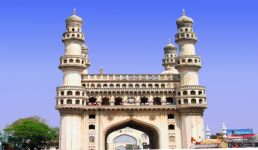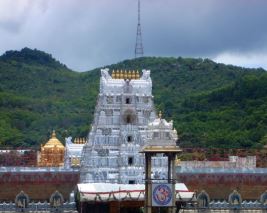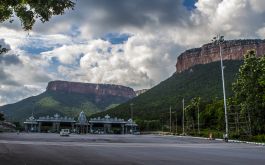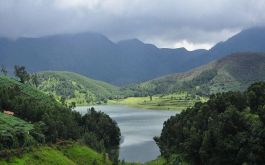The coastal state of Andhra Pradesh is in the southeastern region of India. It shares its land borders with 5 Indian states and its water border with the Bay of Bengal. Andhra Pradesh is a popular holiday destination in the country and is mainly known for its long coastline, natural landforms, incredible local culture and traditions, grand festivals, etc. Besides these, the region used to be a prime pilgrimage site for people of the Buddhist faith. One can find various remains of ancient stupas, monasteries, chaityas, and other sites related to Buddhism across the state. Andhra Pradesh has also seen the reign of several rulers and dynasties since ancient times, including Mauryan Empire, Eastern Chalukyas, Vijayanagara Empire, Mughal Empire, Deccan Sultanates, and so on. The traces of such a diverse history is evident in the city architecture and monuments in the region.
The vivid past of Andhra Pradesh stretches far beyond the period of early history. It has been a massive hub of history, religion and culture in India since ancient times. The monuments found within Andhra Pradesh reflect a crucial section of the region’s rich history. Some well-known examples of such monuments are Konda Reddy Fort, Victory at Sea War Memorial, Dhyana Buddha Statue, Gandhi Hill, etc.
Monuments in Andhra Pradesh
From ancient temples and royal forts to war memorials and towering statues, you can find various types of monuments in Andhra Pradesh. Some of these structures have played a significant role in history, while others were built to commemorate notable events and individuals. Here is a list of famous monuments of Andhra Pradesh that you can check out:
Konda Reddy Fort:
It is a massive fort, locally called Kondareddy Buruju, located in Kurnool, just 2 kilometres from the city’s main railway station. It is a site of major historical significance, drawing the attention of both tourists and history buffs from all over India. According to experts, the construction of the Konda Reddy Fort dates back to the 12th century AD, when it was a part of the Vijayanagara Empire. After its initial construction, this fort has seen several additions to its structure under successive rulers. This stone-and-mud-built fort has three levels and was used as a watch tower between the 17th and 18th century AD. The main highlights of the Konda Reddy Fort are its brilliant architecture, bastions, underground tunnels and gateways.
- Location: Old Bus Stand Area, Kurnool, Andhra Pradesh,
- Prices charged: No entry fee,
- Best time/season to visit: The fort remains open from 9 AM to 6 PM. Consider visiting early in the morning to get the best panoramic view of the city from the fort.
Gooty Fort:
The Gooty Fort is a hill fort in Andhra Pradesh’s Gooty town. This historical site is centrally recognised and protected as a monument of national importance. Even though it is now mostly in ruins, the fort had once served various rulers, including the Marathas, Chalukyas, Mughals and East Indian Company. Nestled at an elevation of 300 metres, the Gooty Fort covers a massive area and features remnants of granaries, ramparts, temples, gunpowder magazines, bastions, storerooms and so on. It is one of the most famous historical monuments in Andhra Pradesh.
- Location: Gooty, Anantapur District, Andhra Pradesh,
- Prices charged: No entry fee,
- Best time/season to visit: The fort remains open from 9 AM to 6 PM and is ideal for a visit at any time of the year. However, consider visiting during the winter as the summer heat can be uncomfortable.
Gandhi Hill:
Located in Vijayawada, Gandhi Hill is one of the prime tourist attractions of Andhra Pradesh. With an elevation of 150 metres, the hill is known for housing a memorial dedicated to the father of our nation, M.K. Gandhi. The memorial site features seven stupas and a stone slab with inscriptions of Gandhi Ji’s famous quotes written on it. The major attraction of the site is the 52-foot-tall Gandhi Stupa which was revealed on October 6th 1968, by the then-president of India, Dr. Zakir Husain. It is an important monument that pays homage to one of India’s great leaders. Other attractions at Gandhi Hill include the Mahatma Gandhi Library, the Sound and Light Show and a toy train ride.
- Location: J.N Road, Tarapet, Vijayawada, Andhra Pradesh,
- Prices charged: INR 10 per person, INR 20 per person for the Toy Train ride,
- Best time/season to visit: The memorial remains open from 4:30 PM to 8:30 PM, and the best time to check it out is between October to March.
Kondapalli Fort:
The Kondapalli Fort is one of the most iconic historical monuments in Andhra Pradesh. Popular belief suggests that this beautiful 14th-century fort was built by Prolaya Vema Reddy of the Reddi Kingdom. It initially served as a palace and was later converted into a military training base under the British. The fort has been a prominent part of the region’s history and has changed hands multiple times. Lying amidst lush greenery, the main attractions of the fort are the Dargah Darwaja, Dargah of Gareeb Saheeb, Golconda Darwaza, Tanisha Mahal, and a few remnants of other structures. It is one of the best places to visit in Andhra Pradesh if you want to learn about its vivid history.
- Location: Ghat Road, Kondapalli, Andhra Pradesh,
- Prices charged: INR 30 per adult, INR 10 per child,
- Best time/season to visit: The site remains open to tourists from 10 AM to 5 PM. Consider visiting during the weekdays to avoid large crowds.
Amaravathi Mahachaitya:
Next on the list of Andhra Pradesh famous monuments is the Amaravathi Mahachaitya. It is an ancient Buddhist stupa believed to have been built during the reign of the Mauryan Empire. Even though it is now mostly in ruins, the stupa used to house several Buddhist sculptures and relics. The major portion of the structure was damaged during an excavation led by Major Colin Mackenzie back in the 1800s. The surviving sculptures were transferred to different museums in India and abroad, still kept in pristine condition. Historians believe that the Amaravathi Mahachaitya used to be a crucial Buddhist education abode in the region, as indicated by the engravings found at the site.
- Location: Amaravathi, Andhra Pradesh,
- Prices charged: INR 20 per adult, INR 250 per head for foreigners,
- Best time/season to visit: The site remains open from 9 AM to 6 PM and is ideal for visiting at any time of the year.
Chandragiri Fort:
The Chandragiri Fort and Palace is a historical landmark in the Tirupati district. This architectural marvel was built during the 11th century AD by the Yadava rulers. However, it was mostly associated with the Vijayanagara Empire, which ruled Chandragiri for around three centuries. The fort’s architecture is a perfect example of the Indo-Saracenic style of that period, made using lime mortar and granite stones. It is one of the most famous monuments in Andhra Pradesh, which draws thousands of tourists around the year. The main attractions of the fort are the temples, its incredible fortification, light and sound show, Rani Mahal, Raja Mahal and several other ruined structures.
- Location: Chandragiri, Tirupati District, Andhra Pradesh,
- Prices charged: INR 45 for adults, INR 35 for Children (age 5-12),
- Best time/season to visit: The fort is open to tourists between 9 AM to 5 PM. You can visit the Chandragiri Fort at any time of the year.
Victory at Sea War Memorial:
The Victory at Sea War Memorial is a famous tourist attraction in Vizag. This monument was built in 1996, following the Indo-Pakistani War of 1971, and is dedicated to the Indian Navy. The memorial features several missiles, models of fighter planes and tankers, which help illustrate a picture of the war. The story behind the memorial is that during the 1971 Liberation War, the Pakistani Navy attempted to destroy INS Vikrant, an Indian aircraft carrier, by attacking the Visakhapatnam Port. However, they failed in achieving the feat due to the quick response led by the Indian Navy, who were, in turn, able to destroy the Pakistani submarine, PNS Ghazi. The Victory at Sea War Memorial is one of the most significant monuments in Andhra Pradesh that you can visit during your Andhra Pradesh trip.
- Location: Beach Road, Visakhapatnam, Andhra Pradesh,
- Prices charged: No entry fee,
- Best time/season to visit: The memorial is open to tourists from 12 AM to 12 PM and is a must-visit at any month of the year.
Penukonda Fort:
The Penukonda Fort is one of the most important Andhra Pradesh historical monuments. Located just 70 kilometres from Anantapur, the fort sits on top of a hill and is made of stone and lime mortar. The architecture of the fort resembles a blend of Hindu and Islamic styles. The Penukonda Fort, formerly called Ghanagiri, used to be Vijayanagara Empire’s second capital. According to the sculptures and inscriptions found within the fort, archaeologists conclude that it was built during the reign of King Bukka I’s son, Vira Virupanna Udayar of Vijayanagar. The ruined fort is home to several prominent structures with immense historical significance, like the 11-foot-tall Lord Hanuman idol, Gagan Mahal Palace, Babayya Darga, Sher Khan Mosque, an armoury, etc.
- Location: Penukonda, Anantapur District, Andhra Pradesh
- Prices charged: No entry fee.
- Best time/season to visit: You can check out the Penukonda Fort during any month around the year.
Dhyana Buddha Statue:
The Dhyana Buddha Statue is a massive statue of Lord Buddha sitting in his meditative state. It is one of the tallest statues of Buddha in India, with a height of 125 feet. The statue’s construction began in 2003 and was finally completed in 2015. Lying on the banks of river Krishna, the Dhyana Buddha Statue is a beautiful modern sculpture that commemorates the Buddhist heritage of the region. It lies within 2 minutes walking distance of the famous Amaravathi Mahachaitya.
- Location: Amaravathi, Andhra Pradesh.
- Prices charged: INR 20 per head.
- Best time/season to visit: The site stays open from 8 AM to 6 PM. Tourists usually prefer visiting the statue early in the morning or during the afternoon.
Hill Fort of Madakasira:
It is a 16th-century fort built on a hilltop in a town named Madakasira in Sri Sathya Sai District. The Madakasira Fort resembles the shape of a horseshoe and is centrally protected as one of the monuments of national importance. According to historians, the fort was constructed by an individual named Siruda Rrangappa, who also established the Madakasira village (then called “Matakapalle”). Since its inception, the fort has changed several hands and seen new structural additions to its complex. The Madakasira Fort is home to several structures, including seven gates, temples, well, palaces, etc. The hill fort of Madakasira is one of the most important historical monuments in Andhra Pradesh.
- Location: Madakasira, Sri Sathya Sai District, Andhra Pradesh.
- Prices charged: U/A.
- Best time/season to visit: If you want to explore the fort and its surrounding area, consider visiting it during the morning hours.















